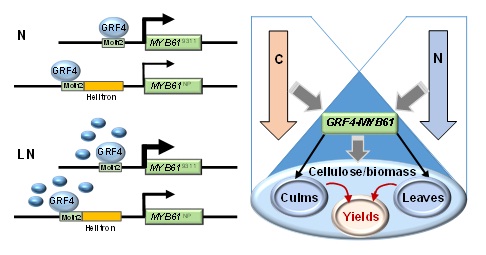Nitrogen (N) is an important macronutrient element to boost plant growth. Plants uptake N from soils to facilitate carbon dioxide (CO2) fixation to generate sugars, organic acids, and carbohydrates, referred to as carbon (C) metabolism. More than 70% of the CO2 assimilated products are converted into cell wall polysaccharides to build the plants themselves, showing as plant growth. Therefore, nitrogen-mediated plant growth is highly coordinated with plant cell wall biogenesis. However, the clear-cut molecular links between cell wall production and nitrogen use remain unclear.
It is widely known that application of inorganic N fertilizer has greatly increased global food production, which also causes N pollution, threatening environmental safety and sustainable agriculture. Improvement of crop N-use efficiency (NUE) is an important solution of this urgent issue.
The group of Prof. ZHOU Yihua from the Institute of Genetics and Developmental Biology, Chinese Academy of Sciences (CAS), recently reported the identification of a variation at the MYB61, a transcription factor that is controlled by a nitrogen integrative regulator GRF4, which explains the differences in nitrogen utilization efficiency and cellulose biogenesis between indica and japonica subspecies in rice.
They performed QTL analysis in a set of chromosomal segment substitution lines generated from indica variety 9311 and japonica variety Nipponbare (NP) and identified a QTL coregulating N-mediated leaf area changes and cellulose content. Gene cloning indicated this locus to a natural variation at a transcriptional factor MYB61. Evidence from genetic and molecular biological analyses revealed that a variation (presence/absence of a helitron transposon) at the MYB61 promoter region confers the divergence in NUE and cellulose content between NP and 9311.
They further found that MYB61 is induced by low N availability and regulated by GRF4; GRF4 is pivotal to control cellulose biogenesis by directly binding to the promoter region of MYB61 and activating MYB61 transcription. MYB61 has several haplotypes, among which the helitron transposon in the MYB61 promoter region is present in all examined japonica varieties, but was absent in the indica varieties, resulting in different transcription of MYB61. MYB61 likely proceeded this selection while indica-japonica divergence.
Furthermore, field trials showed that the indica allele of MYB61 confers the japonica introgression lines with robustness in simultaneously governing nitrogen use and biomass production, leading to improved grain yield, especially at limited N supply.
This finding in identifying the GRF4-MYB61 regulatory module as a link of C&N metabolism uncovers the mechanism for C&N coordination and provides a solution to maintenance of grain yield while reducing agricultural N use in crop production.
This work was published online in
Nature Communications entitled “MYB61 Is Regulated by GRF4 and Promotes Nitrogen Utilization and Biomass Production in Rice” with GAO Yihong , XU Zuopeng and ZHANG Lanjun as the first authors on Oct. 15, 2020 (
DOI: 10.1038/s41467-020-19019-x). Prof. ZHOU Yihua and Dr. ZHANG Baocai are co-corresponding authors.
This work was collaborated with the teams of Prof. QIAN Qian (China National Rice Research Institute, Chinese Academy of Agricultural Sciences) and Prof. LIU Qiaoquan (College of Agriculture, Yangzhou University).
This research was supported by the CAS grants for XianDao A, the National Natural Science Foundation of China, and Youth Innovation Promotion Association of CAS, as well as the State Key Laboratory of Plant Genomics.
Figue. The working model of rice GRF4-MYB61 regulatory module that coordinates carbon &nitrogen metabolism and improves nitrogen use efficiency and grain yield. N, Normal nitrogen; LN, Low nitrogen. (Image by IGDB)
Contact:
QI Lei
Institute of Genetics and Developmental Biology, Chinese Academy of Sciences
 Figue. The working model of rice GRF4-MYB61 regulatory module that coordinates carbon &nitrogen metabolism and improves nitrogen use efficiency and grain yield. N, Normal nitrogen; LN, Low nitrogen. (Image by IGDB)Contact:QI LeiInstitute of Genetics and Developmental Biology, Chinese Academy of SciencesEmail: lqi@genetics.ac.cn
Figue. The working model of rice GRF4-MYB61 regulatory module that coordinates carbon &nitrogen metabolism and improves nitrogen use efficiency and grain yield. N, Normal nitrogen; LN, Low nitrogen. (Image by IGDB)Contact:QI LeiInstitute of Genetics and Developmental Biology, Chinese Academy of SciencesEmail: lqi@genetics.ac.cn CAS
CAS
 中文
中文




.png)
